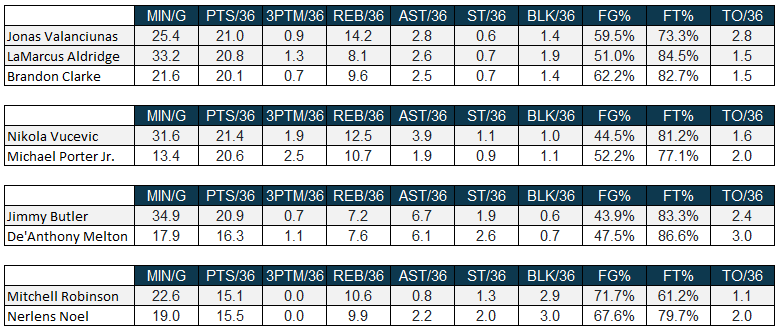-
January 30, 2020, 3:18 pm
Last Updated on January 30, 2020 3:18 pm by Mike Passador | Published: January 30, 2020
In this wonderfully addicting game of fantasy basketball, nothing beats the feeling of picking up a player and watching him break out on your roster. And if you happen to play in a keeper or dynasty league, it can even make your decade. But how can we identify these future breakout players?
Well, for the most part, we don’t. We pick up players on hot streaks and maybe 10% of them improve enough to stick on our rosters. Then, a handful of those guys become fantasy stars. In some formats, we can stash just about every player with any upside whatsoever just in case one of them explodes. But even that’s not foolproof. And these days, everyone has all the same unending information at their fingertips, so it’s nearly impossible for a player to go unnoticed for long.
It’s definitely maddening and certainly entertaining. One of the ways I like to try to identify what the future might hold for a player is by examining his per-36 numbers. It can be any amount of minutes that we look at, of course. 36 just happens to be a commonly used standard, though it is a bit outdated. Only six players are currently averaging at least 36 minutes per game this season. But I guess it is a good number to use if you want to dream about what a player might do if they broke out enough to play league-leading minutes and hit their ceiling.
As an attempt to pick out players that are likely to be top-50 mainstays in the future, this week I’m highlighting four players whose per-36 stats rank in the top-30 but who play significantly fewer minutes at the moment. Each of these players could find themselves with a big minutes increase, even if it may not happen this season. So what I’ve done here is, rather than treat these low-minute, off-brand players as replacements for the name brand guys they’re matched up with, use the established player as more of a statistical comparison goal for the youngster. Note that it’s only the numbers that the players necessarily have in common, not playing styles, body type, career arc, etc.
A few final notes before we get to the comparisons: The top players that fit what I was looking for this week happened to be mostly big men, which makes sense, as they are more likely to have a tough time staying on the floor for very long. I left out a couple veterans that have no chance of playing big minutes on a regular basis in the future in 32-year-old JaVale McGee and 30-year-old Gorgui Dieng (though we just caught a glimpse of him with a temporary big role with Karl-Anthony Towns out). But very impressive work by those two with the minutes they do get.
And just because we all want to see these numbers, here are Matisse Thybulle’s defensive stats per 36 minutes: 2.9 steals and 1.6 blocks.
*These stats are through 1/26.

First up is Brandon Clarke. That’s definitely impressive company he’s mingling with there. And based on his college stats, Clarke’s defensive numbers will probably improve. In the next few years, if not sooner, Clarke should be able to surpass the minutes that current teammate Jonas Valanciunas regularly plays, but LaMarcus Aldridge‘s minutes would be tough to match. That still predicts that Clarke, already 23, could settle into third or fourth-round territory without needing much to change outside of his minutes.
Next, we gaze upon the much-hyped and previously much-injured Michael Porter Jr. It was tough to find a match for him, but I went with Nikola Vucevic. You have to squint a bit because it’s a trade-off: Vuc’s assists for MPJ’s FG%. Porter has a long way to go before he’s able to play something like 30 minutes per game, let alone earn them on a contending team. But the possibility that the 21-year-old could break into the top-25 someday like Vucevic did is worth paying for the lottery ticket in many league formats.
And we’ve got another young Grizzly to gawk at in the third grouping in De’Anthony Melton. The 21-year-old second-year guard seems like the least likely of the three to find himself in a regular 28 to 32-minute role, even though that’s what the fantasy community is clamoring for. It’s certainly possible that he displaces Dillon Brooks in the starting lineup at some point, but that may not come for a while if at all. If he does get over 30 mpg someday, though, we could see an off-brand Jimmy Butler. A version with fewer points and free throw attempts, but still a fantasy mainstay. I think it’s worth mentioning that any of these young players might perform better on a per-minute basis than they do right now as they improve. However, it may be just as likely that their output will decrease if they move into the starting lineup and defer to better players.
Finally, I thought I’d have some fun with a still-surprisingly-young Nerlens Noel. At 25, he could still easily make a jump to someone’s starting lineup and reside there for years. If the Thunder trade Steven Adams this season or if Noel signs with a team that wants to play him something like the 29 mpg he received during his rookie season, we might finally have the Nerlens Noel, or should I say Mitchell Robinson, that we’ve been waiting for. Remember how highly Robinson was ranked in the preseason? It’s worth remembering that Noel’s fantasy line is similar, yet better in many aspects, on a per-minute basis. It’s just a matter of either of them securing a big enough role to realize their potential. Robinson showed us late last season that their ceiling is at least borderline first-round production.
So, what should we do with this information? In redraft leagues, these four players are already owned or should be owned in case a breakout comes soon. In keeper and dynasty leagues, these young players would make for excellent trade targets. Go get them before you have to pay the price we think they’ll soon be worth.
